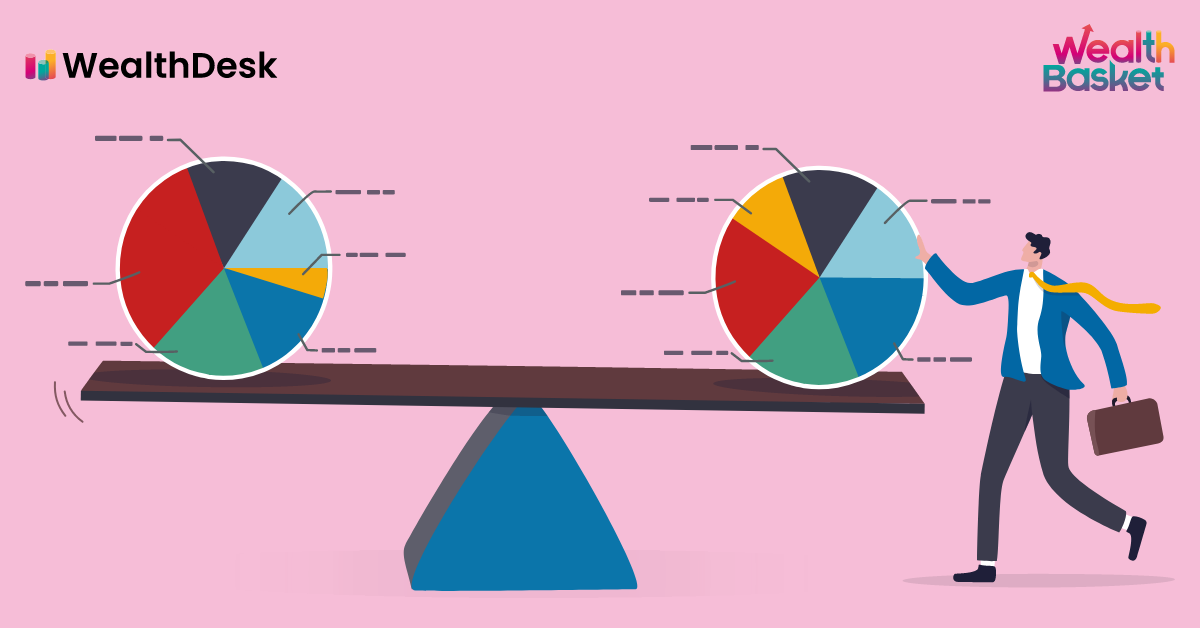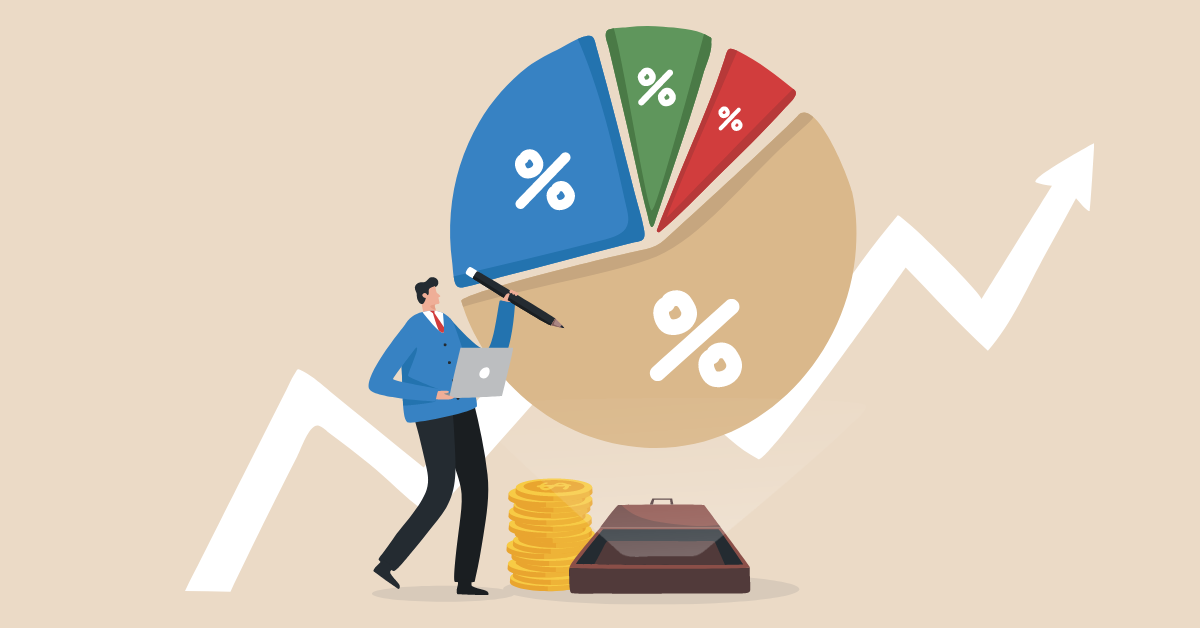Every once in a while, your portfolio might need to ‘rebalanced’ so that it still follows the investment strategy you set or so that it follows your new investment strategy. This blog explores what exactly rebalancing is, how often should you do it, how you should do it and the different types of rebalancing.
What is portfolio rebalancing?
Over time, the risk-to-return ratios of assets might change. You might see your risk profile and financial needs change. So, you might need to check your portfolio and realign it with your financial goals every once in a while.
Re-thinking how you divide your funds between assets and asset classes is called portfolio rebalancing. It involves periodically buying or selling assets to ensure you don’t take on too much risk or fall short of your goals.
In the following sections, we look at why portfolio rebalancing is important, how often should it be done, how should you do it and some rebalancing strategies.
Why is rebalancing your portfolio important?
Rebalancing your portfolio helps to stay in line with your asset allocation strategy and implement any changes you make in your strategy. Some of the benefits of rebalancing your portfolio are listed below:
-
Helps maintain the original asset mix
Over time, you might notice that your portfolio’s asset mix changes. 2 reasons this might happen are disproportionate returns and unplanned investing and disinvesting.
The returns from each asset may be different. They may be in the form of income or capital gains. You might make some investment decisions without paying attention to your asset mix.
Thus, the asset mix of your portfolio may change over time. So, after some time, your investments’ risks and expected returns might not suit you. You could fix this by rebalancing your portfolio.
-
Better risk management
The risks associated with an asset can change over time. Some growth stocks might stabilise, and their risk levels might drop. Some assets might become riskier. You might need to reevaluate your portfolio’s risks and shift the asset mix if needed.
Systematic portfolio rebalancing allows you to control how much risk you are taking.
-
Useful in implementing changes in investment
strategy
As you grow older and more experienced, you might discover new strategies. Most investors also become risk-averse as they grow old. If you regularly rebalance your portfolio, your portfolio will align with your evolving investing style and strategy.
How Often Do You Need to Rebalance Your Portfolio?
You can rebalance your portfolio periodically or when the asset mix changes by a certain amount. Ideally, you want to avoid panic trades from over-checking and also be able to monitor your portfolio.
Periodic rebalancing allows you regularly monitor and control the risk in your portfolio. A con of rebalancing periodically is that you might end up overdoing it. Even if you schedule rebalancing on a certain date, you don’t necessarily have to change the asset mix if the portfolio still suits you.
The other method is to rebalance when the asset allocation shifts. When the asset mix of your portfolio changes, its risk-to-return ratio may no longer suit you. So, investors might prefer to rebalance their portfolios when the asset mix changes too much.
A common rule of thumb used by investors is to rebalance when the asset allocation for any subset shifts by 5%. If you followed this rule and the portion of stocks increases by 5%, you would rebalance.
How to do Portfolio Rebalancing?
- DIY – Do It Yourself
There are two steps to rebalancing. First, you need to Identify the sections for which the allocation has changed. Then, you need to make trades to get back to the old asset mix. If you decide on a different asset allocation, you could make the trades to reach the new asset allocation.
DIY rebalancing is suitable for investors who can make time for it and know the asset markets well enough to execute trades.
- Fund Managers
You can choose to invest in funds dedicated to an investment philosophy that suits you. The fund managers would be responsible for rebalancing.
At WealthDesk, you can find curated portfolios called WealthBaskets. These are portfolios of stocks and ETFs managed by SEBI registered professionals. Subscribers can rebalance these portfolios with just one click!
Every WealthBasket is based on a theme and follows a certain investment strategy. All underlying assets are transferred to the subscriber’s Demat account.
- Apps and Software
Nowadays, you can find various apps and software to help you rebalance your portfolio. They may empower you to rebalance periodically and according to shifts in asset allocation. However, you should be wary of fraudulent software. To ensure your safety, you should look if the app or software is approved by authorities like SEBI.
Relying on fund managers and software is sometimes called automatic portfolio rebalancing.
Discover stocks that suit certain filter criteria and dive into details to check their WealthBaskets.
Different Types of Portfolio Rebalancing Strategies
Periodic Rebalancing
Periodic rebalancing involves committing to rebalancing your portfolio with a fixed interval. Periodic rebalancing allows you to monitor your portfolio regularly. However, some investors may fall into the trap of overdoing rebalancing when not needed. You need not rebalance if your portfolio still suits you.
Threshold-Based Rebalancing
When you set your rebalancing according to the changes in asset allocation, it is called threshold-based rebalancing. As we have discussed earlier, the goal is to maintain a certain asset mix. If your desired asset mix changes, you may decide to rebalance accordingly.
Risk Parity Rebalancing
You may decide to rebalance your portfolio when the overall risk of the portfolio increases. You may also decide to rebalance when the asset allocation to risky assets go beyond a certain point. This form of rebalancing is called risk parity rebalancing.
Takeaway
Portfolio rebalancing is important to make sure your portfolio suits you. It allows you to manage risk and implement changes per your evolving investment style. Nowadays, rebalancing a portfolio is not limited to just DIY trades. There is numerous handy software you could use. The optimum frequency of rebalancing a portfolio depends on how much time you want to dedicate to managing your investments.
In addition to curated portfolios, WealthDesk is also building a platform to connect financial news, advisory, investing and broking. Stay tuned!
FAQs
Rebalancing in a stock portfolio would involve shifting funds from risky and maybe even low performing stocks to stocks with lower risk or stocks that are expected to perform better.
Rebalancing can be done in 2 ways. You could rebalance your portfolio by selling the asset you have an excess of and buying the asset you have too little of. Or, you could add new funds to your portfolio and focus on buying the assets you have too little of.
Investors should rebalance their portfolios only when the asset mix has changed, and the portfolio no longer suits them. Those who have set periodic rebalancing should avoid rebalancing when not needed.
Rebalancing is done to maintain the asset mix of your portfolio, manage its risk and implement the changes in your investing style.


















